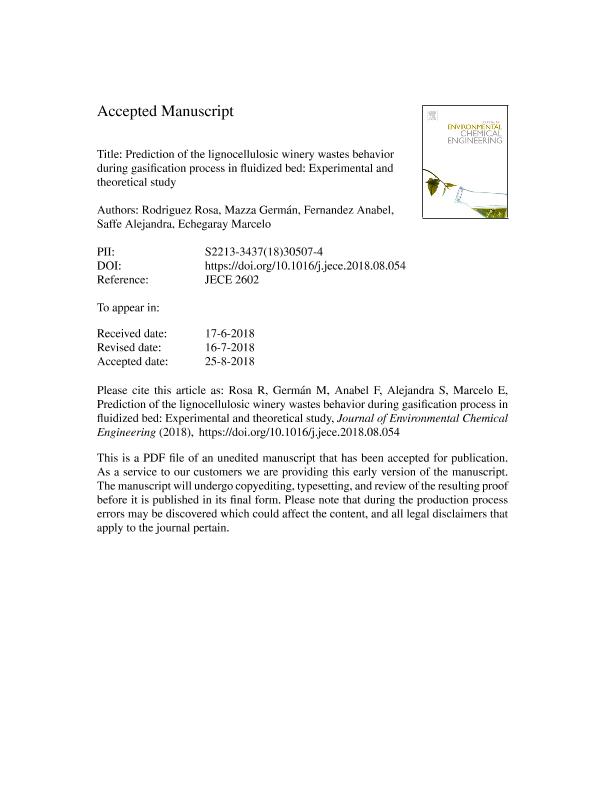Mostrar el registro sencillo del ítem
dc.contributor.author
Rodriguez, Rosa Ana

dc.contributor.author
Mazza, German Delfor

dc.contributor.author
Fernandez Brizuela, Anabel Alejandra

dc.contributor.author
Saffe Pinto, María Alejandra

dc.contributor.author
Echegaray, Marcelo Eduardo

dc.date.available
2019-11-13T21:37:28Z
dc.date.issued
2018-08
dc.identifier.citation
Rodriguez, Rosa Ana; Mazza, German Delfor; Fernandez Brizuela, Anabel Alejandra; Saffe Pinto, María Alejandra; Echegaray, Marcelo Eduardo; Prediction of the lignocellulosic winery wastes behavior during gasification process in fluidized bed: Experimental and theoretical study; Elsevier; Journal of Environmental Chemical Engineering; 6; 4; 8-2018; 5570-5579
dc.identifier.issn
2213-3437
dc.identifier.uri
http://hdl.handle.net/11336/88814
dc.description.abstract
This work presents studies about the gasification of the lignocellulosic winery wastes in fluidized bed to obtain energy. Based on the exergy analysis, the exergetic improvement potential (IP) and sustainability index (SI) variations with different operational variables were analyzed. IP increases and SI decreases when moisture content, ER and SBR augment. On the other hand, both indexes present contrary behavior with the temperature increasing. Additionally, the kinetic behavior was investigated using a macro thermo-balance. The thermal decomposition of the studied biomass wastes at three heating rate, 5, 10 and 15 °C/min under steam/air mixture atmosphere show that the gasification takes place in three visible stage: water vaporization, pyrolysis and the last step associated with the reaction of the char by CO 2 . The distributed activation energy model method (DAEM) was used. The decomposition is not a single reaction stage, it includes the contributions of parallel reaction steps on the global reaction rate. Last, the fluidization was analyzed using air at room temperature and local atmospheric pressure. Each experiment was carried out with 100% and 75% v lignocellulosic wastes. Segregation, slugging and channelization in all studied cases. However, the addition of sand particles improves the behavior of both winery wastes.
dc.format
application/pdf
dc.language.iso
eng
dc.publisher
Elsevier

dc.rights
info:eu-repo/semantics/openAccess
dc.rights.uri
https://creativecommons.org/licenses/by-nc-sa/2.5/ar/
dc.subject
EXERGETIC IMPROVEMENT POTENTIAL
dc.subject
FLUIDIZED BED
dc.subject
FLUIDODYNAMIC STUDY
dc.subject
KINETIC ANALYSIS
dc.subject
LIGNOCELLULOSIC WINERY WASTES
dc.subject
SUSTAINABILITY INDEX
dc.subject.classification
Ingeniería de Procesos Químicos

dc.subject.classification
Ingeniería Química

dc.subject.classification
INGENIERÍAS Y TECNOLOGÍAS

dc.title
Prediction of the lignocellulosic winery wastes behavior during gasification process in fluidized bed: Experimental and theoretical study
dc.type
info:eu-repo/semantics/article
dc.type
info:ar-repo/semantics/artículo
dc.type
info:eu-repo/semantics/publishedVersion
dc.date.updated
2019-10-28T18:39:04Z
dc.journal.volume
6
dc.journal.number
4
dc.journal.pagination
5570-5579
dc.journal.pais
Países Bajos

dc.journal.ciudad
Amsterdam
dc.description.fil
Fil: Rodriguez, Rosa Ana. Consejo Nacional de Investigaciones Científicas y Técnicas. Centro Científico Tecnológico Conicet - Patagonia Norte. Instituto de Investigación y Desarrollo en Ingeniería de Procesos, Biotecnología y Energías Alternativas. Universidad Nacional del Comahue. Instituto de Investigación y Desarrollo en Ingeniería de Procesos, Biotecnología y Energías Alternativas; Argentina
dc.description.fil
Fil: Mazza, German Delfor. Consejo Nacional de Investigaciones Científicas y Técnicas. Centro Científico Tecnológico Conicet - Patagonia Norte. Instituto de Investigación y Desarrollo en Ingeniería de Procesos, Biotecnología y Energías Alternativas. Universidad Nacional del Comahue. Instituto de Investigación y Desarrollo en Ingeniería de Procesos, Biotecnología y Energías Alternativas; Argentina
dc.description.fil
Fil: Fernandez Brizuela, Anabel Alejandra. Consejo Nacional de Investigaciones Científicas y Técnicas. Centro Científico Tecnológico Conicet - Patagonia Norte. Instituto de Investigación y Desarrollo en Ingeniería de Procesos, Biotecnología y Energías Alternativas. Universidad Nacional del Comahue. Instituto de Investigación y Desarrollo en Ingeniería de Procesos, Biotecnología y Energías Alternativas; Argentina
dc.description.fil
Fil: Saffe Pinto, María Alejandra. Consejo Nacional de Investigaciones Científicas y Técnicas. Centro Científico Tecnológico Conicet - Patagonia Norte. Instituto de Investigación y Desarrollo en Ingeniería de Procesos, Biotecnología y Energías Alternativas. Universidad Nacional del Comahue. Instituto de Investigación y Desarrollo en Ingeniería de Procesos, Biotecnología y Energías Alternativas; Argentina
dc.description.fil
Fil: Echegaray, Marcelo Eduardo. Consejo Nacional de Investigaciones Científicas y Técnicas. Centro Científico Tecnológico Conicet - Patagonia Norte. Instituto de Investigación y Desarrollo en Ingeniería de Procesos, Biotecnología y Energías Alternativas. Universidad Nacional del Comahue. Instituto de Investigación y Desarrollo en Ingeniería de Procesos, Biotecnología y Energías Alternativas; Argentina
dc.journal.title
Journal of Environmental Chemical Engineering
dc.relation.alternativeid
info:eu-repo/semantics/altIdentifier/url/https://www.sciencedirect.com/science/article/pii/S2213343718305074
dc.relation.alternativeid
info:eu-repo/semantics/altIdentifier/doi/http://dx.doi.org/10.1016/j.jece.2018.08.054
Archivos asociados
